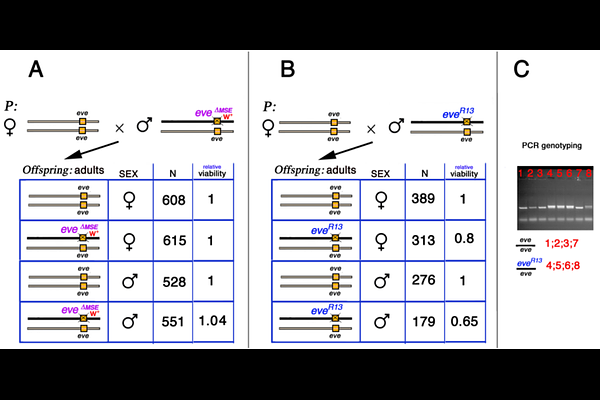The near-normal viability of heterozygote for a lethalenhancer allele suggests a route for cis-regulatory evolution.

The near-normal viability of heterozygote for a lethalenhancer allele suggests a route for cis-regulatory evolution.
Ludwig, M. Z.
AbstractA variety of evolutionary processes shape the structure of cis-regulatory elements such as enhancers. Functionally important regulatory sequences tend to be conserved as result of negative selection against deleterious mutations and positive selection for better-canalized performance. However, some forms of stabilizing selection can maintain functional conservation of cis-regulatory elements for long periods of evolutionary time despite structural transcription binding sites turnover (Ludwig et al, 1998). In addition, compensatory evolution can even accelerate the substitution process in large populations to level greater than the neutral rate of substitution (Carter and Wagner, 2002). The effects of lethal mutations in cis-regulatory regions on viability in heterozygotes and the impact of such mutations on evolutionary processes have not been substantially addressed. We ask a fundamental biological question: How does a lethal mutant in an enhancer region affect viability when carried over a dominant normal allele? Here cis-regulatory mutation eve dMSE of even-skipped gene (eve) in D. melanogaster, that is lethal in homozygote, has been tested for relative viability in heterozygous state. In eve dMSE the 480-bp fragment corresponding to MSE (Minimal Stipe Element) of the eve stripe 2 enhancer was deleted and replaced with an unrelated DNA fragment (containing white+ gene marker) by ends-out homologous recombination (Ludwig et al, 2011). We discovered that relative viability of flies carrying cis-regulatory mutation eve dMSE in heterozygote was not reduced compared to the viability of wild-type flies. In contrast, the viability of heterozygotes carrying a homozygote-lethal nonsense eveR13 mutation (Fujioka et al, 1999) was significantly impacted. Our explanation to this surprising phenomenon relays on action of eve transcriptional autoregulation. The transcription factor (TF) EVE regulates its own expression level through the autoregulatory cis-regulatory module. It could elevate the expression level from one dose to the level sufficient to restore up to 100% fitness in the heterozygote with eve dMSE lethal allele. This example suggests that some cis-regulatory mutants (including the deleterious ones) may exist in populations as heterozygotes with high fitness for many generations, before possibly encountering an epistatic interaction with a compensatory mutation at a different site in the genome. Our study is consistent with the compensatory mechanisms of evolution for functionally important cis-regulatory elements.